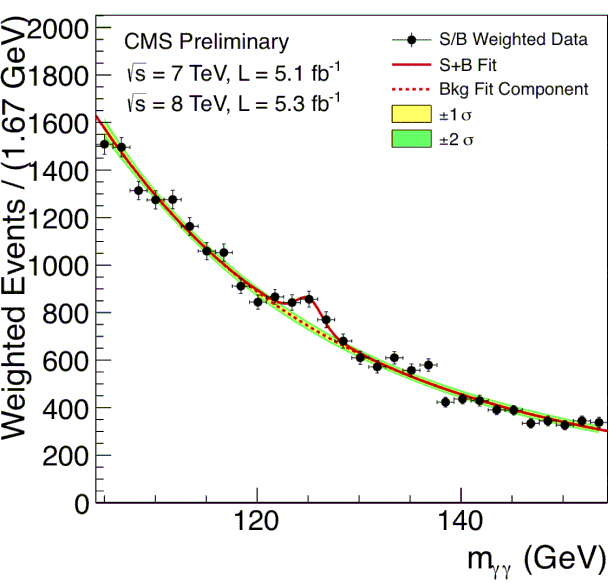Create a free profile to get unlimited access to exclusive videos, sweepstakes, and more!
Higgs!

The Nobel Prize in Physics 2013 was awarded jointly to François Englert and Peter W. Higgs on Oct. 8 for their discovery of the Higgs Boson. Phil Plait wrote this post on July 4, 2012, when the discovery was announced.
Scientists using the Large Hadron Collider in Geneva have announced the discovery of a new subatomic particle to very high confidence that is consistent with what we expect the Higgs particle to look like.
Ye. GADS.
This plot shows the discovery as seen in one of the LHC detectors. Hang tight, and I'll explain it!
OK, the quick version. The Higgs particle is extremely important, because the Standard Model of particle physics - the basic idea of how all particles behave - predicts it exists and is what (indirectly) gives many other particles mass. In other words, the reason electrons, protons, and neutrons have mass is because of this Higgs beastie. Last year, the Guardian put up a nice article explaining this. A more technical discussion is on Discover Magazine's Cosmic Variance blog from 2007. Sean Carroll has been live-blogging the announcement, and has lots of good info as well.
This particle is very hard to detect, because it doesn't live long. Once it forms it decays in a burst of energy and other particles (think of them as shrapnel) extremely rapidly. The only way to make them is to smash other particles together at incredibly high energies, and look at the resulting collisions. If the Higgs exists, then it will decay and give off a characteristic bit of energy. The problem is, lots of things give off that much energy, so you have to see the Higgs signal on top of all that noise.
So, you have to collide particles over and over again, countless times, to build up that tiny signal from the Higgs decay. The more you do it, the bigger the signal gets, and the more confident you can be that the detection is real. I described all this in detail last December, when preliminary results from LHC were announced. I strongly urge you to read that first!
Back now? Good. So last year, an excess signal was seen at an energy around 125 GeV - that's a unit of energy physicists use, and it also indicates the mass of the particle decaying. Because energy and mass are interchangeable at some level, detecting the energy emitted when a particle decays tells you its mass.
A proton has a mass of about 1 GeV, so this excess found is about 125 times that much. Last year's results were tantalizing, but the strength of the signal only led to a confidence level of about 90% that it was real. Nice, but not enough to claim a discovery.
Today that all changed. Two different detectors at the LHC both independently found a strong signal between 125 and 126 GeV at about the 5 sigma level - that means they can claim a 99.9999% confidence this signal is real! This means they found a previously undiscovered particle which, as it happens, is within the range of mass the Standard Model predicts for the Higgs particle! That's what that plot above shows: a bump in the energies detected, and it's seen so strongly that it can be called a discovery.
That's huge.
Now technically, that's all the physicists can say: the particle is definitely there. But is it the Higgs? Well, to be fair, they can't actually say that. But if it walks like a Higgs, looks like a Higgs, and quacks like a Higgs... yeah.
So there you have it. A new fundamental particle has been found, and if it's the Higgs - which it really really really looks like it is - is the first step to our truly understanding such basic concepts as mass and gravity in the Universe. It's technical, and it's complicated, and it's the result of a vast amount of time, money, and effort by thousands upon thousands of people... but it's real.
And it's only the first step. There's much work to be done. But oh, what a step. The Universe has once again done something wonderful -- let us peek behind the curtain and get a glimpse of its inner workings.
Never forget this either: we humans did this. The discovery of this new particle, and the vast potential it has, was all because we're curious. This huge machine, the LHC, was built solely because we wanted to find things out, and some people had the vision to fund it and build it. When we wish to explore, when we wish to see what's over the next hill, wonders unfold before us.
All we have to do is want it enough.
Image credit: CERN
Â
Related Posts:
- Mass effect: Maybe Higgs, maybe not
- Europe: Day 3 â CERN! The LHC!
- Brian Cox calls âem like he sees âem
- LHC smacks some phrotons (with video I took when I visited the LHC in 2008)
Â















